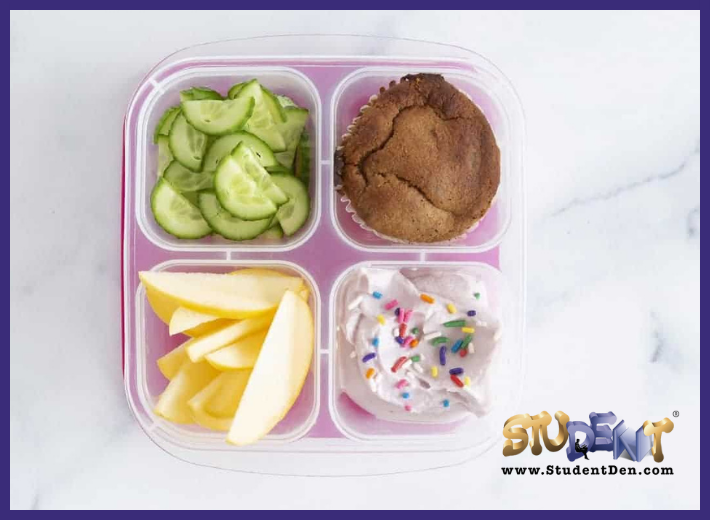Parents often face challenges when it comes to feeding picky eaters and ensuring they receive the necessary nutrients for optimal growth and learning. Here, we bring you seven practical and creative tips to help transform camp and school lunches into a positive and enjoyable experience for both parents and children.
Are you packing a school lunch for a picky eater? Getting your child to eat healthfully is a struggle for many parents. In this slideshow, Johns Hopkins pediatric dietitian Meredith Thivierge offers school lunch tips for picky eaters to help you prepare meals with the vitamins, minerals and nutrients your child needs to grow and succeed in school.
Children, especially younger children, can be influenced by how the food looks. Fun shapes and bright colors may grab their attention and encourage them to take a bite. You don’t have to spend a lot of time carving cartoon characters out of bologna. Just take a few minutes to arrange the lunch neatly, add a personal note or use a cookie cutter to shape a sandwich or slice of cheese to add visual interest to the meal. “If the food looks fun and appetizing to you, there is a good chance your picky eater will also find it appetizing,” Thivierge says.
You may have to get creative to make sure your picky eater’s lunch covers the five major food groups: fruits, vegetables, protein, grains and dairy. If your child is allergic to or intolerant of specific foods, it may be worth talking to your pediatrician about a multivitamin or supplement. If dietary restrictions are not an issue, you can try sneaking in foods your picky eater refuses to eat. “Blending cauliflower with mashed potatoes or adding spinach to a fruit smoothie are a few ways parents can trick their children into eating healthy foods,” Thivierge suggests. She also advises asking your child why they dislike certain foods. If they simply don’t like the texture or look, this can sometimes be remedied by trying different cooking techniques.
Picky eaters, and children in general, are more likely to eat something if they helped to make it. Participation gives kids a sense of ownership in the final product and helps them see exactly what’s inside that sandwich or salad they are having for lunch. You can involve your children at every stage of the process, from picking a recipe to food shopping and meal preparation. “Together you could create a list of foods your children enjoy and that you approve of and then have them choose from this list,” recommends Thivierge. This allows parents to remain in control while giving a child the freedom of choice.
It’s important to keep introducing new foods to your picky eater, as it can take 10 to 20 times of trying a food before a child may start liking it. However, school lunch may not be the best time for it. Children tend to get distracted during lunch and often don’t have enough time to finish everything they have in their lunch box. They may start with more familiar foods and are more likely to ignore new items. Thivierge suggests introducing new foods at dinner when the whole family can encourage the child to try something new.

Start working on your school lunch menu based on the foods your child agrees to eat. “It helps to make a list of all foods your picky eater tolerates, but it’s also important to find different ways to serve them,” Thivierge says. For example, if cucumber is the only vegetable your picky eater will stomach, try serving it with different dips or roll it up with lunch meats and cheese. The United States Department of Agriculture website has a variety of recipes created with input from school children to help you find new school lunch ideas. Changing it up is the key to keeping your child from losing interest in the few healthy foods they like.
What do you picture when you think about a typical school lunch? Is it a ham and cheese sandwich, a carton of milk and an apple? Although there is nothing wrong with sandwiches, they can get boring quickly. Why limit yourself to traditional lunch foods? It’s perfectly fine to pack soups, salads, quesadillas and even breakfast foods for lunch. You could come up with theme days like “mac ’n cheese Mondays” so that your child knows what to expect. “And if your child wants to eat lunch at school, that’s okay too. Find a balance between school lunches and packed lunches and plan these meals together,” Thivierge says.
Children tend to mirror their parents. If you don’t eat lunch and instead snack all day, your child may start skipping lunch too. Or if you enjoy a cupcake before dinner, your picky eater may start filling up on dessert before they get to the healthy part of the school lunch. “Leading with a good example is important, especially when it comes to foods you as a parent may be picky about,” points out Thivierge. If you serve mushrooms to your child, yet pick them off of your own plate, your child may follow your cues.
Ready to empower your child with academic excellence and support? Student Den can provide personalized support to guide your child toward success. Together, let’s nurture their academic potential while addressing their unique needs. Contact us today at 561.213.3794 and follow us at @thestudentden to get more learning tips and insights!
Reference: [https://www.hopkinsmedicine.org/health/wellness-and-prevention/7-school-lunch-tips-for-picky-eaters]